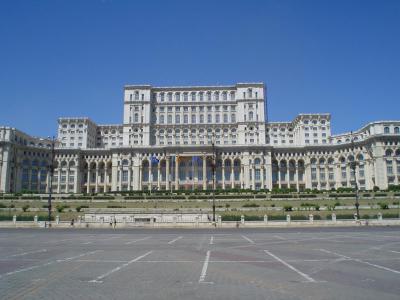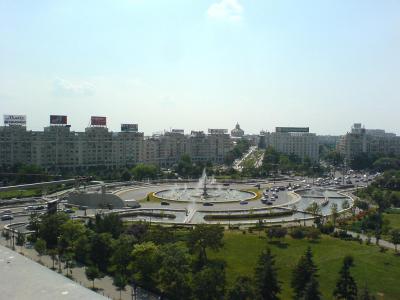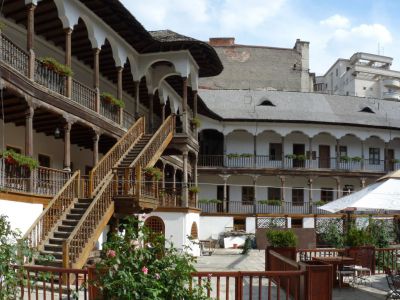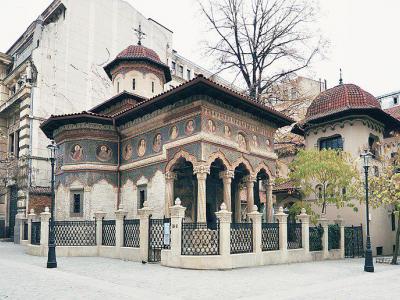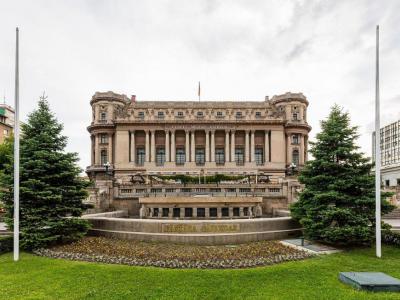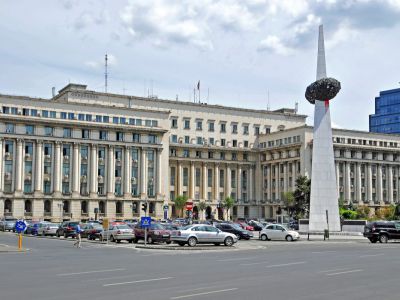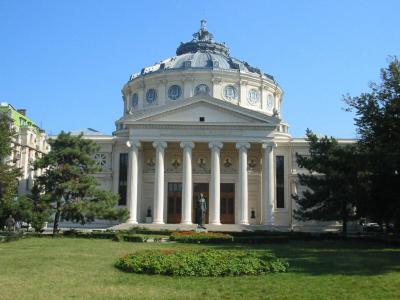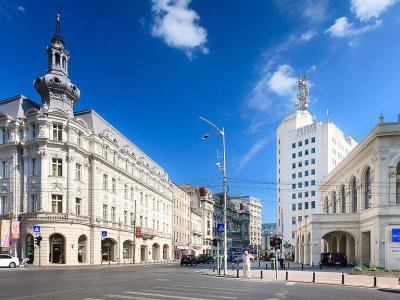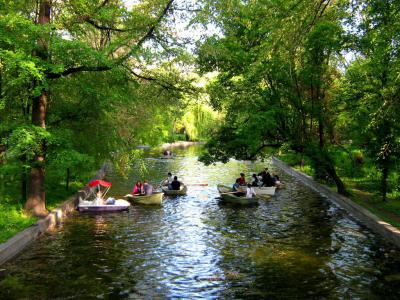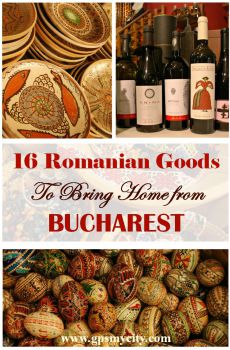Bucharest Introduction Walking Tour (Self Guided), Bucharest
Bucharest, the capital and cultural center of Romania, is one of the largest cities in Southeastern Europe.
The name București has an unverified origin. Tradition links it to the guy named Bucur, who (according to various legends) was either a prince, outlaw, fisherman, shepherd or a hunter. The Romanian word “bucurie” means joy (happiness), which in turn explains one of Bucharest's several nicknames, the “city of joy”. Other etymologies imply derivations from the word Bukovie, a beech forest, or a certain fellow named Abu-Kariș, who came from the tribe of Bani-Kureiș.
First mentioned as the “Citadel of București” in 1459, the town became permanent location of the Wallachian court during the reign of Vlad III the Impaler, in 1698. The medieval remnants from that period, still found in the Lipscani neighborhood, include Hanul lui Manuc (Manuc's Inn), tiny Eastern Orthodox Stavropoleos Church, and the ruins of Curtea Veche (the Old Court).
In 1862, after Wallachia and Moldavia united into the Principality of Romania, Bucharest became the new nation's capital city, and later, in 1881, that of the newly-proclaimed Kingdom of Romania. That period brought about a new phase in the urban development of Bucharest. Romanian Athenaeum, constructed from 1886 to 1888, is a living monument to that (part of the European Heritage since 2007) and a symbol of Romanian culture.
In between two world wars, the city's elegant architecture and cosmopolitan sophistication of its elite earned Bucharest the titles “Little Paris” and “Paris of the East”, in which Calea Victoriei (Victory Avenue) was seen as its analogue to Champs-Élysées.
The city suffered heavy damage during World War II. After the establishment of Communism in Romania, Bucharest saw much of its historic center razed and built upon with new developments. One of the iconic landmarks of Socialist Realism, emerged in the 1980s under the dictatorship of Nicolae Ceaușescu, is the Palace of the Parliament, a massive government complex of 1,100 rooms.
Following the Romanian Revolution of 1989, and notably since 2000, the city has enjoyed continuous modernization prompted by both economic and cultural boom. In 2017, Bucharest was declared a European city with the highest growth of tourists staying overnight.
To feel yourself part of the Romanian capital's bustling scene and to explore its alternated history reflected in an impressive mix of medieval, interbellum, communist era and modern sights, take this self-guided walking tour.
The name București has an unverified origin. Tradition links it to the guy named Bucur, who (according to various legends) was either a prince, outlaw, fisherman, shepherd or a hunter. The Romanian word “bucurie” means joy (happiness), which in turn explains one of Bucharest's several nicknames, the “city of joy”. Other etymologies imply derivations from the word Bukovie, a beech forest, or a certain fellow named Abu-Kariș, who came from the tribe of Bani-Kureiș.
First mentioned as the “Citadel of București” in 1459, the town became permanent location of the Wallachian court during the reign of Vlad III the Impaler, in 1698. The medieval remnants from that period, still found in the Lipscani neighborhood, include Hanul lui Manuc (Manuc's Inn), tiny Eastern Orthodox Stavropoleos Church, and the ruins of Curtea Veche (the Old Court).
In 1862, after Wallachia and Moldavia united into the Principality of Romania, Bucharest became the new nation's capital city, and later, in 1881, that of the newly-proclaimed Kingdom of Romania. That period brought about a new phase in the urban development of Bucharest. Romanian Athenaeum, constructed from 1886 to 1888, is a living monument to that (part of the European Heritage since 2007) and a symbol of Romanian culture.
In between two world wars, the city's elegant architecture and cosmopolitan sophistication of its elite earned Bucharest the titles “Little Paris” and “Paris of the East”, in which Calea Victoriei (Victory Avenue) was seen as its analogue to Champs-Élysées.
The city suffered heavy damage during World War II. After the establishment of Communism in Romania, Bucharest saw much of its historic center razed and built upon with new developments. One of the iconic landmarks of Socialist Realism, emerged in the 1980s under the dictatorship of Nicolae Ceaușescu, is the Palace of the Parliament, a massive government complex of 1,100 rooms.
Following the Romanian Revolution of 1989, and notably since 2000, the city has enjoyed continuous modernization prompted by both economic and cultural boom. In 2017, Bucharest was declared a European city with the highest growth of tourists staying overnight.
To feel yourself part of the Romanian capital's bustling scene and to explore its alternated history reflected in an impressive mix of medieval, interbellum, communist era and modern sights, take this self-guided walking tour.
How it works: Download the app "GPSmyCity: Walks in 1K+ Cities" from Apple App Store or Google Play Store to your mobile phone or tablet. The app turns your mobile device into a personal tour guide and its built-in GPS navigation functions guide you from one tour stop to next. The app works offline, so no data plan is needed when traveling abroad.
Bucharest Introduction Walking Tour Map
Guide Name: Bucharest Introduction Walking Tour
Guide Location: Romania » Bucharest (See other walking tours in Bucharest)
Guide Type: Self-guided Walking Tour (Sightseeing)
# of Attractions: 10
Tour Duration: 2 Hour(s)
Travel Distance: 3.7 Km or 2.3 Miles
Author: DanaOffice
Sight(s) Featured in This Guide:
Guide Location: Romania » Bucharest (See other walking tours in Bucharest)
Guide Type: Self-guided Walking Tour (Sightseeing)
# of Attractions: 10
Tour Duration: 2 Hour(s)
Travel Distance: 3.7 Km or 2.3 Miles
Author: DanaOffice
Sight(s) Featured in This Guide:
- Palace of the Parliament
- Piața Unirii (Union Square)
- Manuc's Inn
- Lipscani Street
- Stavropoleos Convent
- The National Military Circle
- Revolution Square and Memorial of Rebirth
- Romanian Athenaeum
- Calea Victoriei (Victory Avenue)
- Cișmigiu Gardens
1) Palace of the Parliament (must see)
The Palace of the Parliament in Bucharest is a multi-purpose building which houses both chambers of the Romanian Parliament. According to the World Records Academy, the Palace is the world's largest civilian building, most expensive administrative building, and heaviest construction. The Palace was designed and nearly completed under the Ceauşescu regime as the seat of political and administrative power. Nicolae Ceauşescu named it the House of the Republic, although many Romanians call it the People's House.
Built on the site of a hill variously known as Spirii Hill, Uranus Hill, or Arsenal Hill, which was largely razed for this mega project in 1980, the building anchors the west end of Unification Boulevard and Civic Center. Constructing the Palace and Civic Center required demolishing much of Bucharest's historic district, including 19 Orthodox Christian churches, six Jewish synagogues, three Protestant churches (plus eight churches had to be relocated), and 30,000 residences. The construction began in 1983; the cornerstone was laid on 25 June 1984.
While the building was intended to house all four major state institutions (in a similar manner to the UK Houses of Parliament), Ceausescu opted to make the palace his personal residence and have the government operate in it (as if confining the Moscow Kremlin to one building). By the time Nicolae Ceauşescu was overthrown and executed in 1989, the building had been almost complete. Some of the initially planned furnishings were never installed, and the last three basement levels and a large clock tower (meant to display the official Romanian time) were never finished.
Built on the site of a hill variously known as Spirii Hill, Uranus Hill, or Arsenal Hill, which was largely razed for this mega project in 1980, the building anchors the west end of Unification Boulevard and Civic Center. Constructing the Palace and Civic Center required demolishing much of Bucharest's historic district, including 19 Orthodox Christian churches, six Jewish synagogues, three Protestant churches (plus eight churches had to be relocated), and 30,000 residences. The construction began in 1983; the cornerstone was laid on 25 June 1984.
While the building was intended to house all four major state institutions (in a similar manner to the UK Houses of Parliament), Ceausescu opted to make the palace his personal residence and have the government operate in it (as if confining the Moscow Kremlin to one building). By the time Nicolae Ceauşescu was overthrown and executed in 1989, the building had been almost complete. Some of the initially planned furnishings were never installed, and the last three basement levels and a large clock tower (meant to display the official Romanian time) were never finished.
2) Piața Unirii (Union Square) (must see)
Union Square (Piata Unirii) stands as one of Bucharest’s central and busiest public spaces, both geographically and historically significant. Once the site of an old marketplace known as Great Square (Piata Mare), the square has undergone multiple transformations, especially during the communist period, when it was expanded and reshaped to accommodate grand boulevards and monumental architecture. Today, it serves as a major traffic hub, linking several important roads and metro lines, while anchoring visitors in the heart of the Romanian capital.
To the north of the square lies the grand Bulevardul Unirii, designed to mirror the Champs-Élysées in Paris and lined with fountains that come to life during the summer with coordinated light and music shows. At its western edge, the imposing Unirea Shopping Center provides retail and dining options, while nearby green spaces and wide sidewalks make the square a common meeting point for locals and tourists alike. The square is also within walking distance of major landmarks such as the Palace of the Parliament and the Old Town (Lipscani), making it a convenient starting point for exploration.
Architecturally, Union Square reflects the city’s shifting identity-from its utilitarian communist buildings to more recent commercial developments and restored historical facades. Though not always praised for its aesthetic cohesion, the square’s scale and energy offer a snapshot of Bucharest’s urban evolution. Whether you're using it as a transport junction, admiring the fountains, or simply people-watching, Union Square encapsulates the contrasts and momentum of modern-day Bucharest.
To the north of the square lies the grand Bulevardul Unirii, designed to mirror the Champs-Élysées in Paris and lined with fountains that come to life during the summer with coordinated light and music shows. At its western edge, the imposing Unirea Shopping Center provides retail and dining options, while nearby green spaces and wide sidewalks make the square a common meeting point for locals and tourists alike. The square is also within walking distance of major landmarks such as the Palace of the Parliament and the Old Town (Lipscani), making it a convenient starting point for exploration.
Architecturally, Union Square reflects the city’s shifting identity-from its utilitarian communist buildings to more recent commercial developments and restored historical facades. Though not always praised for its aesthetic cohesion, the square’s scale and energy offer a snapshot of Bucharest’s urban evolution. Whether you're using it as a transport junction, admiring the fountains, or simply people-watching, Union Square encapsulates the contrasts and momentum of modern-day Bucharest.
3) Manuc's Inn (must see)
Nestled in the vibrant heart of Old Town, Manuc’s Inn (Hanul lui Manuc), built in 1806–1808 by Armenian-Turkish merchant-diplomat Emanuel Marzaian-known as Manuc Bey-stands as the city’s oldest operating hotel building. Originally conceived as a khan (inn) on the banks of the Dambovita River, it quickly grew into a major commercial and cultural hub. By the mid-19th century, the complex boasted 107 rooms, 15 wholesalers, 23 shops, two reception halls, pubs, taverns, and a charming courtyard encircled by balconied galleries.
Beyond lodging and trade, Manuc’s Inn played host to pivotal historical moments. In 1812, it was the venue for the preliminary negotiations and signing of the Treaty of Bucharest, ending the Russo‑Turkish War from 1806 to 1812. Later, in 1842, it briefly housed Bucharest's town hall, and around 1880 became the scene of the first Romanian operetta performances. Its grand ''Dacia Hall'' also rang with political debates before World War I, further cementing its role as a cultural and civic meeting place.
Though Manuc’s Inn has weathered fire, earthquakes, nationalization under communism, and numerous restorations, its original architectural essence-marked by its courtyards, wooden balconies, and elegant arches-remains wonderfully intact. Today, the Inn melds centuries-old charm with contemporary life: visitors can wander its leafy courtyard, savor traditional Romanian cuisine in its vaulted cellar restaurant, enjoy a coffee or glass of wine on a sunlit balcony, or browse artisan shops lining its street-facing side.
For tourists, a visit to Manuc’s Inn is an invitation to travel back in time-to imagine caravans resting under the courtyards, diplomats negotiating peace, and citizens gathering for culture and commerce. Located just steps from the Old Court ruins (Curtea Veche) and a stone’s throw from Union Square (Piata Unirii), it remains an essential stop on any walking tour of Lipscani’s atmospheric streets.
Beyond lodging and trade, Manuc’s Inn played host to pivotal historical moments. In 1812, it was the venue for the preliminary negotiations and signing of the Treaty of Bucharest, ending the Russo‑Turkish War from 1806 to 1812. Later, in 1842, it briefly housed Bucharest's town hall, and around 1880 became the scene of the first Romanian operetta performances. Its grand ''Dacia Hall'' also rang with political debates before World War I, further cementing its role as a cultural and civic meeting place.
Though Manuc’s Inn has weathered fire, earthquakes, nationalization under communism, and numerous restorations, its original architectural essence-marked by its courtyards, wooden balconies, and elegant arches-remains wonderfully intact. Today, the Inn melds centuries-old charm with contemporary life: visitors can wander its leafy courtyard, savor traditional Romanian cuisine in its vaulted cellar restaurant, enjoy a coffee or glass of wine on a sunlit balcony, or browse artisan shops lining its street-facing side.
For tourists, a visit to Manuc’s Inn is an invitation to travel back in time-to imagine caravans resting under the courtyards, diplomats negotiating peace, and citizens gathering for culture and commerce. Located just steps from the Old Court ruins (Curtea Veche) and a stone’s throw from Union Square (Piata Unirii), it remains an essential stop on any walking tour of Lipscani’s atmospheric streets.
4) Lipscani Street (must see)
Lipscani Street is the beating heart of Bucharest’s Old Town, a vibrant pedestrian artery that beautifully intertwines medieval charm with bustling modern life. Stretching for nearly a kilometre, Lipscani has been central to the city’s identity since its first mention in 1589, originally known as Broad Lane (Ulita Mare). Its name derives from “lipscan,” the Romanian word for merchants from Leipzig-“Lipsca”-who traded here, making it a lively hub where fine European goods arrived in Wallachia.
The street thrived especially during the reign of Princes Constantin Brancoveanu and Serban Cantacuzino in the late 17th and early 18th centuries, becoming home to guilds and several hanuri (merchant inns) such as The Linden Tree Inn (Hanul cu Tei), which still stands today with its original vaulted cellars and façade. Nearby, the impressive National Bank of Romania occupies the former Serban Voda Inn site, its grand eclectic façade a testament to the late 19th-century architectural ambitions. These buildings reveal layers of Baroque, Neo‑Classical, and Brancovenesc styles-an architectural narrative of a street that evolved from trade epicentre to cultural landmark.
Throughout the 20th century, Lipscani suffered neglect-from wartime damage to Communist-era dereliction-but escaped major demolition and began a dramatic revival in the early 2000s. Today, it pulses with life: cafés, atmospheric bars, boutique shops, and cultural gems occupy restored spaces. Highlights include the iconic Caru’ cu Bere (est. 1899), a Gothic‑Revival gem, and Carturesti Carusel, a stunning early-20th-century bookstore in a former Phanariot bank building. Close by, visiting the Old Princely Court ruins and Stavropoleos Church offers a dip into medieval Bucharest.
For visitors, Lipscani is an immersive time-travel journey. By day, historic façades and narrow cobbles beckon. By night, it transforms into the lifeblood of Bucharest’s culinary and nightlife scene. Whether you're exploring its rich architecture, dashing from a coffee house to a craft beer bar, or simply soaking in the spirited atmosphere, Lipscani is where the city’s past and present meet-and it’s a must-do introduction to the soul of Bucharest.
The street thrived especially during the reign of Princes Constantin Brancoveanu and Serban Cantacuzino in the late 17th and early 18th centuries, becoming home to guilds and several hanuri (merchant inns) such as The Linden Tree Inn (Hanul cu Tei), which still stands today with its original vaulted cellars and façade. Nearby, the impressive National Bank of Romania occupies the former Serban Voda Inn site, its grand eclectic façade a testament to the late 19th-century architectural ambitions. These buildings reveal layers of Baroque, Neo‑Classical, and Brancovenesc styles-an architectural narrative of a street that evolved from trade epicentre to cultural landmark.
Throughout the 20th century, Lipscani suffered neglect-from wartime damage to Communist-era dereliction-but escaped major demolition and began a dramatic revival in the early 2000s. Today, it pulses with life: cafés, atmospheric bars, boutique shops, and cultural gems occupy restored spaces. Highlights include the iconic Caru’ cu Bere (est. 1899), a Gothic‑Revival gem, and Carturesti Carusel, a stunning early-20th-century bookstore in a former Phanariot bank building. Close by, visiting the Old Princely Court ruins and Stavropoleos Church offers a dip into medieval Bucharest.
For visitors, Lipscani is an immersive time-travel journey. By day, historic façades and narrow cobbles beckon. By night, it transforms into the lifeblood of Bucharest’s culinary and nightlife scene. Whether you're exploring its rich architecture, dashing from a coffee house to a craft beer bar, or simply soaking in the spirited atmosphere, Lipscani is where the city’s past and present meet-and it’s a must-do introduction to the soul of Bucharest.
5) Stavropoleos Convent (must see)
Stavropoleos Convent (Manastirea Stavropoleos) is a hidden treasure tucked away on a quiet lane in Bucharest’s bustling Old Town. Founded in 1724 by Greek archimandrite Ioanichie Stratonikeas under Prince Nicolae Mavrocordatos, the convent-with its cobblestone courtyard and peaceful atmosphere-offers a serene contrast to the energetic cafés and shops just steps away. The name Stavropoleos is derived from the Greek “Stauropolis,” meaning “City of the Cross,” a poetic reminder of the convent's spiritual focus.
Architecturally, the church and remaining convent buildings showcase the exquisite Brancovenesc style-an iconic synthesis of Byzantine, Ottoman, Italian Renaissance, and local influences. You’ll notice its intricately carved stone portico, trilobate arches, floral motifs, and framed religious medallions adorning the facade. Inside, the intimate space is rich with stunning frescoes, gilded icons, and an atmosphere heavy with incense and devotion. Its survival through earthquakes, secularization, and the Ceaușescu era makes visiting feel like stepping back into early 18th-century Bucharest.
Beyond its visual beauty, Stavropoleos is a living center for Orthodox spirituality and cultural heritage. The convent is active with nuns and priests who continue its mission through a renowned Byzantine choir, a library housing over 8,000 theological works and historical manuscripts, and diligent restoration of ancient books, icons, and liturgical garments. Its courtyard also displays fragments rescued from demolished churches, turning this urban nook into a small but poignant museum of Romanian religious art.
For travelers, a visit to Stavropoleos offers much more than architecture-it brings a spiritual and cultural immersion. Entry is free, and the convent welcomes visitors daily from morning to evening. A guided tour or simply lingering inside to absorb the hymns, scents, and sacred ambiance makes this a highlight of any stroll through Bucharest’s Old Town.
Architecturally, the church and remaining convent buildings showcase the exquisite Brancovenesc style-an iconic synthesis of Byzantine, Ottoman, Italian Renaissance, and local influences. You’ll notice its intricately carved stone portico, trilobate arches, floral motifs, and framed religious medallions adorning the facade. Inside, the intimate space is rich with stunning frescoes, gilded icons, and an atmosphere heavy with incense and devotion. Its survival through earthquakes, secularization, and the Ceaușescu era makes visiting feel like stepping back into early 18th-century Bucharest.
Beyond its visual beauty, Stavropoleos is a living center for Orthodox spirituality and cultural heritage. The convent is active with nuns and priests who continue its mission through a renowned Byzantine choir, a library housing over 8,000 theological works and historical manuscripts, and diligent restoration of ancient books, icons, and liturgical garments. Its courtyard also displays fragments rescued from demolished churches, turning this urban nook into a small but poignant museum of Romanian religious art.
For travelers, a visit to Stavropoleos offers much more than architecture-it brings a spiritual and cultural immersion. Entry is free, and the convent welcomes visitors daily from morning to evening. A guided tour or simply lingering inside to absorb the hymns, scents, and sacred ambiance makes this a highlight of any stroll through Bucharest’s Old Town.
6) The National Military Circle
The National Military Circle (Cercul Militar Național) stands proudly near Victory Avenue (Calea Victoriei) in central Bucharest. Conceived as the cultural hub of the Romanian Army, its impressive French neoclassical façade was drawn up by architect Dimitrie Maimarolu, with contributions from Victor Stefanescu and Ernest Doneaud, and built between 1911 and 1923 on the former site of the Sarindar Monastery. Though construction was interrupted by World War I and the subsequent German occupation, the grand palace was restored and inaugurated in February 1923, thanks to donations from army officers and state funding.
Beyond its majestic exterior, the interior of the Circle is a showcase of opulent design. Visitors may glimpse sumptuous halls-such as the Marble, Moorish, Gothic, and Norwegian rooms-each meticulously decorated for ceremony and cultural occasions. A spectacular double marble staircase leads to the upper levels, opening into richly adorned salons and a historic restaurant, serving military and civilians alike since the early 20th century.
Throughout the interwar era, the Circle gained renown for hosting lavish military balls. It was here that young officers sought suitable partners amidst well-dressed debutantes, turning its grand entrance into a social stage and symbol of status in Bucharest society. Under communism, the building was renamed “Casa Centrală a Armatei,” only to reclaim its historic title after 1989.
Today, the Circle remains a living monument: a historic and architectural asset classified under Bucharest’s Grade A heritage listings. It's open to the public via its restaurant, cinema, library, and occasional cultural events-film screenings, book launches, and concerts all breathe new life into its century-old halls. For tourists, it offers a unique opportunity: step into a space where imperial elegance meets military tradition, right in the heart of modern Bucharest.
Beyond its majestic exterior, the interior of the Circle is a showcase of opulent design. Visitors may glimpse sumptuous halls-such as the Marble, Moorish, Gothic, and Norwegian rooms-each meticulously decorated for ceremony and cultural occasions. A spectacular double marble staircase leads to the upper levels, opening into richly adorned salons and a historic restaurant, serving military and civilians alike since the early 20th century.
Throughout the interwar era, the Circle gained renown for hosting lavish military balls. It was here that young officers sought suitable partners amidst well-dressed debutantes, turning its grand entrance into a social stage and symbol of status in Bucharest society. Under communism, the building was renamed “Casa Centrală a Armatei,” only to reclaim its historic title after 1989.
Today, the Circle remains a living monument: a historic and architectural asset classified under Bucharest’s Grade A heritage listings. It's open to the public via its restaurant, cinema, library, and occasional cultural events-film screenings, book launches, and concerts all breathe new life into its century-old halls. For tourists, it offers a unique opportunity: step into a space where imperial elegance meets military tradition, right in the heart of modern Bucharest.
7) Revolution Square and Memorial of Rebirth
Revolution Square (Piața Revoluției) offers a compelling blend of history, culture, and drama, making it a must-visit stop for any traveler in Bucharest. Formerly known as Palace Square until 1989, the plaza was the backdrop for two of Communism’s most dramatic moments: Nicolae Ceaușescu’s celebratory speech in 1968 and his downfall during the 1989 revolution. Today, it’s framed by architectural marvels like the Romanian Athenaeum, the Royal Palace (home to the National Museum of Art), and the elegant Kretzulescu Church-all of which sit mere steps away, offering tourists a fascinating insight into Romania’s turbulent 20th-century narrative.
Anchoring this historic square is the Memorial of Rebirth (Memorialul Renasterii), a striking 25‑metre white marble obelisk topped by a dark metal “crown.” Commissioned in 2004 and unveiled on August 1, 2005, the memorial honors the courage and sacrifice of the Romanian people who overthrew Communism in December 1989. Its design-abstract and open to interpretation-sparked debate: many locals mockingly nicknamed it the “impaled potato” or “olive on a toothpick,” criticizing its symbolism, while others appreciate its stark, modern reminder of national rebirth.
Beyond artistic divides, the memorial’s base holds deeper meaning. Bronze figures, wood crosses representing victims of all ages, and inscribed plaques evoke the human stories behind the revolution’s toll-nearly 1,500 lives lost in December 1989. At night, it’s illuminated with subtle lighting, allowing visitors to reflect on its solemn message long after sunset. For a deeper dive, you’ll also notice bullet scars on nearby buildings-notably the former Central Committee headquarters-reminders of the ferocity of the uprising.
A stroll through Revolution Square, with its imposing monuments and historic facades, is both thought-provoking and inspiring. Stop by during daylight for context-many nearby museums, guided tours, and knowledgeable locals offer vivid descriptions of what unfolded here-and linger into the evening to feel the quiet resonance of a nation that dared to reclaim its freedom.
Anchoring this historic square is the Memorial of Rebirth (Memorialul Renasterii), a striking 25‑metre white marble obelisk topped by a dark metal “crown.” Commissioned in 2004 and unveiled on August 1, 2005, the memorial honors the courage and sacrifice of the Romanian people who overthrew Communism in December 1989. Its design-abstract and open to interpretation-sparked debate: many locals mockingly nicknamed it the “impaled potato” or “olive on a toothpick,” criticizing its symbolism, while others appreciate its stark, modern reminder of national rebirth.
Beyond artistic divides, the memorial’s base holds deeper meaning. Bronze figures, wood crosses representing victims of all ages, and inscribed plaques evoke the human stories behind the revolution’s toll-nearly 1,500 lives lost in December 1989. At night, it’s illuminated with subtle lighting, allowing visitors to reflect on its solemn message long after sunset. For a deeper dive, you’ll also notice bullet scars on nearby buildings-notably the former Central Committee headquarters-reminders of the ferocity of the uprising.
A stroll through Revolution Square, with its imposing monuments and historic facades, is both thought-provoking and inspiring. Stop by during daylight for context-many nearby museums, guided tours, and knowledgeable locals offer vivid descriptions of what unfolded here-and linger into the evening to feel the quiet resonance of a nation that dared to reclaim its freedom.
8) Romanian Athenaeum (must see)
Bucharest’s Romanian Athenaeum (Ateneul Roman) is an iconic masterpiece of neoclassical architecture, inaugurated in 1888. Designed by French architect Albert Galleron, this circular, domed concert hall was built to promote art and science, serving as the home of the “George Enescu” Philharmonic Orchestra. Situated majestically on Victory Avenue (Calea Victoriei), it stands across from the Royal Palace and has earned its reputation as the city’s most prestigious cultural venue and a European Heritage Label site since 2007.
The architecture evokes classical elegance: a grand façade of Doric columns leads into a sumptuous foyer crowned by a glorious rotunda. Inside, warm marble, decorative moldings, ornate chandeliers, and spiral staircases hint at luxury, but it’s the concert hall that steals the show. Here, visitors are treated to a sweeping 75-meter fresco depicting pivotal moments in Romanian history-from Dacia’s ancient roots to the unification of Greater Romania in 1919-as well as impeccable acoustics and almost 800 seats arranged amphitheatrically.
The Athenaeum remains the beating heart of Romanian classical music: the Philharmonic inaugurated the hall in 1889 and continues to perform here, while the annual George Enescu Festival-among the world’s most celebrated classical music events-draws international audiences. Its stage has resonated with premieres by Enescu himself and other notable composers, solidifying the venue’s cultural and historical significance.
For tourists, a visit is a must. Tours are available outside concert hours via the side entrance on Benjamin Franklin Street. Whether attending a performance or simply exploring its gilded domes and frescoes, the Athenaeum offers an intimate glimpse into Romania’s artistic soul and communal spirit.
The architecture evokes classical elegance: a grand façade of Doric columns leads into a sumptuous foyer crowned by a glorious rotunda. Inside, warm marble, decorative moldings, ornate chandeliers, and spiral staircases hint at luxury, but it’s the concert hall that steals the show. Here, visitors are treated to a sweeping 75-meter fresco depicting pivotal moments in Romanian history-from Dacia’s ancient roots to the unification of Greater Romania in 1919-as well as impeccable acoustics and almost 800 seats arranged amphitheatrically.
The Athenaeum remains the beating heart of Romanian classical music: the Philharmonic inaugurated the hall in 1889 and continues to perform here, while the annual George Enescu Festival-among the world’s most celebrated classical music events-draws international audiences. Its stage has resonated with premieres by Enescu himself and other notable composers, solidifying the venue’s cultural and historical significance.
For tourists, a visit is a must. Tours are available outside concert hours via the side entrance on Benjamin Franklin Street. Whether attending a performance or simply exploring its gilded domes and frescoes, the Athenaeum offers an intimate glimpse into Romania’s artistic soul and communal spirit.
9) Calea Victoriei (Victory Avenue) (must see)
Victory Avenue (Calea Victoriei) is one of Bucharest’s most historic and elegant boulevards. Originally a simple trade route connecting Bucharest to the city of Brasov, it was transformed into a paved thoroughfare in the late 17th century under Prince Constantin Brancoveanu. The road was renamed “Calea Victoriei” in 1878 to commemorate Romania’s victory in the War of Independence, and has since become a symbol of the city’s modern ambitions and architectural grandeur.
Lined with a mix of Belle Époque mansions, interwar modernist buildings, and imposing institutions, the avenue reflects the city’s shifting styles and eras. Notable landmarks include the Romanian Athenaeum, the National Museum of Art (formerly the Royal Palace), the CEC Palace with its eclectic dome, and the Revolution Square-an important site during the fall of communism in 1989. The street also hosts several high-end hotels, shops, and cafes, blending culture with commerce in a uniquely urban setting.
Victory Avenue is best explored on foot, especially during weekends when parts of it become pedestrian-only. The blend of heritage facades, tree-lined sidewalks, and occasional street performances creates a leisurely atmosphere ideal for strolling and people-watching. While the traffic and noise of the city persist nearby, the boulevard manages to offer moments of elegance and calm amid the bustle.
For visitors interested in architecture, history, or simply soaking in the spirit of Bucharest, Victory Avenue offers a continuous narrative-one that ties the past to the present with each step taken along its route.
Lined with a mix of Belle Époque mansions, interwar modernist buildings, and imposing institutions, the avenue reflects the city’s shifting styles and eras. Notable landmarks include the Romanian Athenaeum, the National Museum of Art (formerly the Royal Palace), the CEC Palace with its eclectic dome, and the Revolution Square-an important site during the fall of communism in 1989. The street also hosts several high-end hotels, shops, and cafes, blending culture with commerce in a uniquely urban setting.
Victory Avenue is best explored on foot, especially during weekends when parts of it become pedestrian-only. The blend of heritage facades, tree-lined sidewalks, and occasional street performances creates a leisurely atmosphere ideal for strolling and people-watching. While the traffic and noise of the city persist nearby, the boulevard manages to offer moments of elegance and calm amid the bustle.
For visitors interested in architecture, history, or simply soaking in the spirit of Bucharest, Victory Avenue offers a continuous narrative-one that ties the past to the present with each step taken along its route.
10) Cișmigiu Gardens (must see)
Cismigiu Gardens, the oldest public park in Bucharest, is a serene escape in the heart of Romania’s bustling capital. Established in the mid-19th century, the gardens were designed by German landscape architect Carl Friedrich Wilhelm Meyer, who transformed a former swampy area into a picturesque green space. Officially opened in 1854, Cismigiu quickly became a favorite meeting point for locals and visitors alike, offering a peaceful retreat steps away from the city’s busy boulevards.
The park spans nearly 17 hectares and features a harmonious mix of winding alleys, decorative flowerbeds, and mature trees, some of which are over a century old. At its center lies a large ornamental lake, which serves as a boating spot in the summer and a popular ice-skating rink in the winter. Classical statues, charming bridges, and historic monuments, such as the Sissi Stefanidi Monument and the Writers’ Rotunda, add cultural and historical depth to the landscape.
Beyond its natural beauty, Cismigiu Gardens is a vibrant place for leisure and recreation. Visitors can enjoy shaded pathways ideal for strolls, while children can explore the playgrounds scattered throughout the park. Seasonal floral displays, fountains, and ornamental arrangements make it a delightful spot for photography or quiet relaxation.
For tourists, Cismigiu Gardens offers both a glimpse into Bucharest’s 19th-century urban development and a refreshing break from sightseeing. Its central location makes it easy to pair with nearby attractions, such as the University Square or Victory Avenue (Calea Victoriei), while its timeless atmosphere invites a slow-paced, unhurried visit.
The park spans nearly 17 hectares and features a harmonious mix of winding alleys, decorative flowerbeds, and mature trees, some of which are over a century old. At its center lies a large ornamental lake, which serves as a boating spot in the summer and a popular ice-skating rink in the winter. Classical statues, charming bridges, and historic monuments, such as the Sissi Stefanidi Monument and the Writers’ Rotunda, add cultural and historical depth to the landscape.
Beyond its natural beauty, Cismigiu Gardens is a vibrant place for leisure and recreation. Visitors can enjoy shaded pathways ideal for strolls, while children can explore the playgrounds scattered throughout the park. Seasonal floral displays, fountains, and ornamental arrangements make it a delightful spot for photography or quiet relaxation.
For tourists, Cismigiu Gardens offers both a glimpse into Bucharest’s 19th-century urban development and a refreshing break from sightseeing. Its central location makes it easy to pair with nearby attractions, such as the University Square or Victory Avenue (Calea Victoriei), while its timeless atmosphere invites a slow-paced, unhurried visit.
Walking Tours in Bucharest, Romania
Create Your Own Walk in Bucharest
Creating your own self-guided walk in Bucharest is easy and fun. Choose the city attractions that you want to see and a walk route map will be created just for you. You can even set your hotel as the start point of the walk.
Old Town Walking Tour
The Historical Center of Bucharest, or the Old Town, as the locals habitually refer to it, is one of the most beloved and attractive areas in the Romanian capital. The neighborhood is really beautiful a place to visit, and you can walk into it pretty much from anywhere in central Bucharest. Ion Constantin Brătianu Boulevard crosses the historic heart of the city from Piata Universitate... view more
Tour Duration: 2 Hour(s)
Travel Distance: 1.9 Km or 1.2 Miles
Tour Duration: 2 Hour(s)
Travel Distance: 1.9 Km or 1.2 Miles
Useful Travel Guides for Planning Your Trip
16 Uniquely Romanian Things To Buy in Bucharest
Nicknamed "Little Paris", today's Bucharest is the capital of a vibrant European nation, known as Romania, with lots of history and great cultural heritage - spanning from centuries-old rural traditions to New Wave cinema. Keen on rustic stuff, Romanians carefully preserve their...
The Most Popular Cities
/ view all



